Step-by-Step Home Butchering for Sheep, Lambs and Goats with Images
This
is an excerpt
from a great homesteading book on home butchering of every description.
It is called "The
Complete Book of Butchering, Smoking, Curing and Sausage Making" by
Philip Hasheider, published by Voyageur Press. We
have a book
review of this book, and it comes highly recommended for
those of you
homesteading and wanting information on home butchering. Below is an
excerpt from the book on slaughtering sheep, lamb and goats.
Home Butchering and Choosing your Animal
If
you raised your own sheep or goats, you should be able to determine the
healthiest one in your flock as a good candidate for butchering at
home. It
should also be one with the most muscling and least fat.
If you are purchasing a live sheep, goat or a lamb, be sure to examine it first. The eyes, nose, and mouth should be clean with no watering or discharge. It should move about easily without exhibiting any lameness or limping. The presence of either may indicate an injury or other physical illness that will lower the carcass and muscle quality. Observe the animal's breathing pattern. If it is labored or fast, it may indicate lung problems or a fever. Refuse to purchase any animal for home butchering l if the physical signs you see do not appear as normal or you sense something might be wrong.
You may want to consider purchasing a female for home butchering to avoid removing the male sex organs. Some believe there is a distinct difference in meat flavors between a female and an intact male.
Lambs are typically marketed when they reach between 90 to 140 pounds live weight. After slaughter, the resulting carcass will weight roughly 50 % of this amount. Depending on your storage capacity, you may be able to purchase a whole or half carcass for butchering.
If you are purchasing a live sheep, goat or a lamb, be sure to examine it first. The eyes, nose, and mouth should be clean with no watering or discharge. It should move about easily without exhibiting any lameness or limping. The presence of either may indicate an injury or other physical illness that will lower the carcass and muscle quality. Observe the animal's breathing pattern. If it is labored or fast, it may indicate lung problems or a fever. Refuse to purchase any animal for home butchering l if the physical signs you see do not appear as normal or you sense something might be wrong.
You may want to consider purchasing a female for home butchering to avoid removing the male sex organs. Some believe there is a distinct difference in meat flavors between a female and an intact male.
Lambs are typically marketed when they reach between 90 to 140 pounds live weight. After slaughter, the resulting carcass will weight roughly 50 % of this amount. Depending on your storage capacity, you may be able to purchase a whole or half carcass for butchering.
Home Butchering and Handling
Proper handling of sheep
and
goats at all times is good husbandry and minimizes damages or injury to
the live animal. It is particularly important during the time leading
up to the slaughter to reduce the changes of damaging or bruising the
muscles. Bruised muscles yield a lower quality carcass and, if severe
enough, may require the bruises to be cut out of the meat, lowering
your total yield. To prevent bruising, provide sufficient room for the
sheep to move about and still be caught without injury.
Avoid lifting it by its fleece or hair, as this will also cause bruises to the carcass. When moving your animal to the confinement area, place one hand under its jaw and the other at the dock (tail) and lead it.
Be careful of the sheep and goat if it has horns, which can be used in defense if they perceive to be in imminent danger. Sheep or goat horns have pointed tips, which can cause serious injury to anyone handling them.
The process to harvest a sheep or goat is essentially identical, so the following descriptions apply to each.
Avoid lifting it by its fleece or hair, as this will also cause bruises to the carcass. When moving your animal to the confinement area, place one hand under its jaw and the other at the dock (tail) and lead it.
Be careful of the sheep and goat if it has horns, which can be used in defense if they perceive to be in imminent danger. Sheep or goat horns have pointed tips, which can cause serious injury to anyone handling them.
The process to harvest a sheep or goat is essentially identical, so the following descriptions apply to each.
Home Butchering Equipment and Tools
The
minimum equipment you should have available include a sharp skinning
knife for removing the pelt, a table or platform on which to lay the
eviscerated carcass, or a hoist to lift the sheep by the hind legs to
eye or chest level. If available, you can use a cradle, which is a
trough about 6 inches wide at the bottom with sloping sides 6 inches
high to be used for skinning. A dripping pan to catch the blood after
sticking will keep the area below the carcass from becoming messy.
Using a chain-mail glove on your free hand will prevent accidental cuts.
Home Butchering and Stunning and Sticking
Several
methods can be used to either stun or quickly dispatch a sheep.
Inexpensive electrical stunners can be used for only one or two
animals. These use an electrical current to initiate cardiac
arrest to kill the sheep. The animal can then be placed on a table,
cradle or hoist to begin the butchering process.
The simplest method to kill the sheep is to stick the jugular vein with your knife to create blood flow. This can be done by placing the sheep on its side, wrapping the front feet and rear feet together so that the hooves cannot cause you injury, and then placing it on a table or platform with its head draped over the edge.
 If you choose to
hoist the sheep by its hind legs, tie its front legs together with a
rope or cord and then pull it tight towards its hind legs. This will
hold the front legs steady, restrain the sheep, and allow you to make a
swift, clean kill.
If you choose to
hoist the sheep by its hind legs, tie its front legs together with a
rope or cord and then pull it tight towards its hind legs. This will
hold the front legs steady, restrain the sheep, and allow you to make a
swift, clean kill.
To cut the jugular veins, grasp the jaw or ear with one hand and insert the knife behind the jaw while drawing it blade edge outward and out through the pelt. This will sever the jugular veins and carotid arteries.
One advantage of sticking a sheep versus stunning it is that you achieve a more compete bleed from the body because the heart is still beating. If the sheep is suspended by its hind legs, the flow of blood is downward and will continue while the heart works. Gravity will assist in making as complete a bleed as possible. For lambs, the blood yield may be as much as 3 percent of their live weight.
Bleeding out the Sheep
The simplest method to kill the sheep is to stick the jugular vein with your knife to create blood flow. This can be done by placing the sheep on its side, wrapping the front feet and rear feet together so that the hooves cannot cause you injury, and then placing it on a table or platform with its head draped over the edge.
 If you choose to
hoist the sheep by its hind legs, tie its front legs together with a
rope or cord and then pull it tight towards its hind legs. This will
hold the front legs steady, restrain the sheep, and allow you to make a
swift, clean kill.
If you choose to
hoist the sheep by its hind legs, tie its front legs together with a
rope or cord and then pull it tight towards its hind legs. This will
hold the front legs steady, restrain the sheep, and allow you to make a
swift, clean kill.To cut the jugular veins, grasp the jaw or ear with one hand and insert the knife behind the jaw while drawing it blade edge outward and out through the pelt. This will sever the jugular veins and carotid arteries.
One advantage of sticking a sheep versus stunning it is that you achieve a more compete bleed from the body because the heart is still beating. If the sheep is suspended by its hind legs, the flow of blood is downward and will continue while the heart works. Gravity will assist in making as complete a bleed as possible. For lambs, the blood yield may be as much as 3 percent of their live weight.
Bleeding out the Sheep
Home Butchering and Skinning
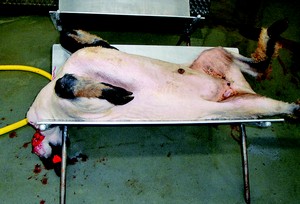 When the blood has finished
flowing from the carcass, you can place the sheep on its back in the
cradle or on a table. To begin skinning the carcass, grasp a foreleg
and slice the skin open with the point of you knife down towards the
chest. Do the same with the other foreleg, having the two cuts meet at
the front of the breastbone. Then finish skinning out both front legs.
When the blood has finished
flowing from the carcass, you can place the sheep on its back in the
cradle or on a table. To begin skinning the carcass, grasp a foreleg
and slice the skin open with the point of you knife down towards the
chest. Do the same with the other foreleg, having the two cuts meet at
the front of the breastbone. Then finish skinning out both front legs.Next skin the hind legs. Begin by holding one leg and open it down the backside from the hoof to the rectum by holding your knife fairly flat as you slice down. Holding it in this way will help avoid cutting the tendon and the colorless connective tissue membrane just under the skin that separates it from the meat in the carcass. All four legs should now be skinless. You can start removing the feet at either the front or rear,
Remove the front feet by cutting through either the breaking joint or spool joint, depending on the age of the animal. In young lambs, the break joint will be a swelling in the long canon bone just above the foot. Break joints in yearlings and older sheep are denser and harder to cut. For these, you should remove the foot at the first joint above the hoof.
To remove the hind feet, begin by removing the foot at the joint closest to the hoof. By not cutting it higher, you will leave the backside tendon anchored, which you can use to suspend the carcass. Carefully slice along the leg bone for about 3 inches, separating tissue holding the tendon to the leg bone. These slits will allow you to insert hooks that will hold the carcass for evisceration. Do the same with the opposite hind leg.
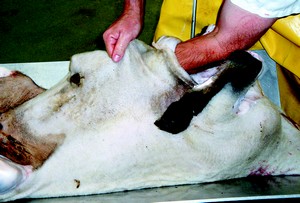 To
separate the skin and fleece from the body, grasp the pelt at the cut,
make a fist with your free hand, and slide it forward separating the
skin from the body. Push your fist against the pelt and not the carcass
as you are loosening it. By repeating this motion, you will loosen the
skin without needing to use a knife. This will eliminate cuts and
bruises to the body of the carcass. Always have clean hands when
loosening the pelt to avoid
Fisting the Pelt
To
separate the skin and fleece from the body, grasp the pelt at the cut,
make a fist with your free hand, and slide it forward separating the
skin from the body. Push your fist against the pelt and not the carcass
as you are loosening it. By repeating this motion, you will loosen the
skin without needing to use a knife. This will eliminate cuts and
bruises to the body of the carcass. Always have clean hands when
loosening the pelt to avoid
Fisting the Peltcontaminating the carcass with wool and dirt from the fleece.
With most of the skin now loosened from the body, you can attach hooks to the hind leg tendons and raise the sheep to a level that allows you to comfortably work with the carcass. Once suspended, you can remove the head by cutting behind the jaw and separating it at the base of the skull.
The trachea and esophagus are still attached to the internal organs and must now be separated so that you can remove those organs during evisceration. You will then be able to pull them out when you remove the internal organs. If this separation is not done, you will need to split the brisket prior to evisceration to remove the abdominal and thoracic organs at the same time.
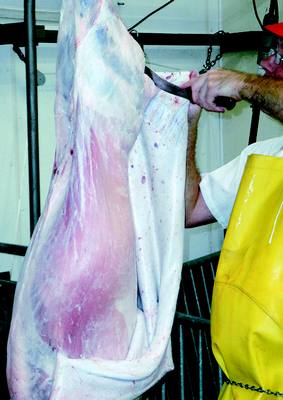 With the carcass suspended, cut open
the center of the loosened pelt. Pull the fleece towards you as you
slice down the belly being careful not to cut into the abdomen.
With the carcass suspended, cut open
the center of the loosened pelt. Pull the fleece towards you as you
slice down the belly being careful not to cut into the abdomen.Loosen all the skin by moving your fist around the entire carcass and up the legs.
Avoid pulling or stripping the pelt off the carcass as this may damage the connective tissue membrane by tearing and exposing the muscle.
Sever the anus by cutting across it where it is attached to the pelt. Then use your fist to loosen it. Finish loosening the pelt at the shoulders. Once the pelt is completely loose it should easily slide off the carcass.
Rinse the carcass with clean, lukewarm water before opening the body cavity. This will remove any
Removing the Anus
dirt, wool, or other foreign materials they may have attached to it.
Home Butchering and Evisceration
Evisceration
of sheep is very much like that of cattle and pigs, except they are
smaller. Avoid cutting into the intestinal and digestive tract while
opening the body cavity so that it is not contaminated by fecal
material.
Place a bucket under the carcass to catch the intestines and blood. Begin by cutting around the anus, loosening it from the pelvis. Cut as close around the pelvic and tail bones as you can until it is free to pull out. You should tie the anus shut with string or a light cord so that any fecal contents do not spill out. Once securely tied, you can let it slide down into the body cavity.
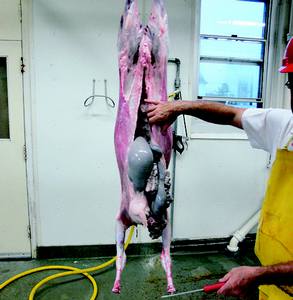 To
open the belly, start your knife top at a point just below the junction
where the outer skin of the two hind legs intersects. Pull the skin
toward you as you make a cut long enough to insert your first and
second fingers to help guide the knife point. Or you can insert the
handle into the abdomen cavity the same way as in cattle or pigs to
open it.
To
open the belly, start your knife top at a point just below the junction
where the outer skin of the two hind legs intersects. Pull the skin
toward you as you make a cut long enough to insert your first and
second fingers to help guide the knife point. Or you can insert the
handle into the abdomen cavity the same way as in cattle or pigs to
open it.
After the body cavity is open, grasp the tied end of the anus that you let slide into the cavity earlier with your free hand and slowly pull the intestines and organs towards you. Gravity will help pull these from the body, and the bladder and kidneys will also drop
Evisceration of the Sheep
as you sever the ureters.
When all the viscera have been removed, split the breastbone with a saw or sturdy knife. Wash both the inside and the outside of the carcass with cool water and remove any traces of blood, dirt, tissue, and other foreign matter. You can also trim any scraggly ends or pieces from around the neck or other areas. The carcass is now ready to cool. Chilling the carcass makes it easier to cut up the various parts as the fat within in the meat and the muscles become firm.
Did you want to see more pictures from this home butchering excerpt? How much meat can you expect to get from your lamb? What are the prime cuts and how do you go about home butchering your lamb to get those delicious leg roasts and crown roasts? Should you split your lamb longitudinally or laterally? Where is the foresaddle and the hindsaddle and what do you do with the leftovers? So many questions on home butchering, but do you have the answers?
Do you have other animals you need to slaughter for home butchering? Pigs perhaps, beef , chickens, rabbits or even venison?
Purchase this excellent book on home butchering for all your slaughtering needs for the homesteading livestock owner.
"The Complete Book of Butchering, Smoking, Curing and Sausage Making" by Philip Hasheider, published by Voyageur Press.
Still not convinced? If you are interested in home smoking and have wondered about smokehouses and how you could build one, see what else Philip Hasheider has to say on the subject from another excerpt of this brilliant little book on home butchering, smoking, curing and sausage making.
Place a bucket under the carcass to catch the intestines and blood. Begin by cutting around the anus, loosening it from the pelvis. Cut as close around the pelvic and tail bones as you can until it is free to pull out. You should tie the anus shut with string or a light cord so that any fecal contents do not spill out. Once securely tied, you can let it slide down into the body cavity.
 To
open the belly, start your knife top at a point just below the junction
where the outer skin of the two hind legs intersects. Pull the skin
toward you as you make a cut long enough to insert your first and
second fingers to help guide the knife point. Or you can insert the
handle into the abdomen cavity the same way as in cattle or pigs to
open it.
To
open the belly, start your knife top at a point just below the junction
where the outer skin of the two hind legs intersects. Pull the skin
toward you as you make a cut long enough to insert your first and
second fingers to help guide the knife point. Or you can insert the
handle into the abdomen cavity the same way as in cattle or pigs to
open it.After the body cavity is open, grasp the tied end of the anus that you let slide into the cavity earlier with your free hand and slowly pull the intestines and organs towards you. Gravity will help pull these from the body, and the bladder and kidneys will also drop
Evisceration of the Sheep
as you sever the ureters.
When all the viscera have been removed, split the breastbone with a saw or sturdy knife. Wash both the inside and the outside of the carcass with cool water and remove any traces of blood, dirt, tissue, and other foreign matter. You can also trim any scraggly ends or pieces from around the neck or other areas. The carcass is now ready to cool. Chilling the carcass makes it easier to cut up the various parts as the fat within in the meat and the muscles become firm.
Did you want to see more pictures from this home butchering excerpt? How much meat can you expect to get from your lamb? What are the prime cuts and how do you go about home butchering your lamb to get those delicious leg roasts and crown roasts? Should you split your lamb longitudinally or laterally? Where is the foresaddle and the hindsaddle and what do you do with the leftovers? So many questions on home butchering, but do you have the answers?
Do you have other animals you need to slaughter for home butchering? Pigs perhaps, beef , chickens, rabbits or even venison?
Purchase this excellent book on home butchering for all your slaughtering needs for the homesteading livestock owner.
"The Complete Book of Butchering, Smoking, Curing and Sausage Making" by Philip Hasheider, published by Voyageur Press.
Still not convinced? If you are interested in home smoking and have wondered about smokehouses and how you could build one, see what else Philip Hasheider has to say on the subject from another excerpt of this brilliant little book on home butchering, smoking, curing and sausage making.
Add your Own Comments on Home Butchering!
We have lots of pages where you can contribute to throughout this homesteading website. We love hearing from our readers, and hope you will be one of those we hear from too. Look around our homesteading website. If you have anything to add here with regards to your own experiences with home butchering please feel free to add them here. We would love to hear from you.
Leave a Comment
Do you have anything that you would like to add after reading this page? We would love to hear your thoughts. If you can add additional information to what has been written here you will be adding value to the website! No need to have any special skills - just type and submit. We will do the rest!
Other Comments
Click below to see comments from other visitors to this page...
Great Instruction on Home Butchering Not rated yet
This has been invaluable instruction on home butchering.
The method of bleeding is very good and I might add, biblical. I also note the technique of …



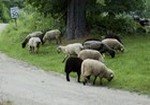

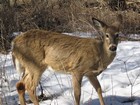
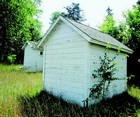
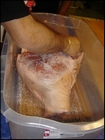
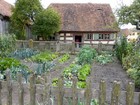
New! Comments
Do you have something of value to add? Leave me a comment in the box below.